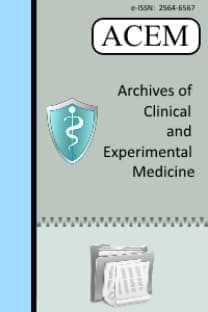Haftalık endoskopik debridmanın endoskopik transkanaliküler diod lazer dakriyosistorinostominin başarı oranı üzerine etkisi
Amaç: Kronik dakriyostenozlu hastalarda endoskopik transkanaliküler diod lazer ile dakriyosistorinostomi sonuçlarını değerlendirmek.
Yöntemler: Bu retrospektif çalışmaya 67 kronik dakriyostenozlu hastanın transkanaliküler lazer ile dakriyosistorinostomi yapılan 75 gözü dahil edildi. Ameliyat sonrası 65 hastaya nazolakrimal kanal açma ve yıkama için 1 ay boyunca her hafta transnazal endoskopik debridman yapıldı (Grup 1, 65 hasta). Postoperatif bakım yapılmayan hastalar Grup 2 (10 hasta) olarak tanımlandılar. Tüm hastalar en son 3. ayda muayene edildiler.
Bulgular: 1. grupta 65 hastanın 63’ünde tam cerrahi başarı sağlandı, iki hastada restenoz gelişti. 2. grupta 10 hastanın altısında başarı sağlandı, ancak dört hastada restenoz gelişti. 1. Grupta cerrahi başarı oranı %98, 2. grupta ise %60 idi (p
Anahtar Kelimeler:
Dakriyosistorinostomi, kronik dakriyostenoz, transkanaliküler diod lazer.
Influence of weekly endoscopic debridement on success rate of endoscopic transcanalicular diode laser dacryocystorhinostomy
Aim: To evaluate the outcomes of transcanalicular diode laser DCR (TL-DCR) in patients with chronic dacryostenosis.
Methods: In this retrospective study we included 75 eyes of 67 patients with chronic dacryostenosis who underwent TL-DCR. In 65 patients transnasal endoscopic debridement the opening and nasalacrimal syringing was performed every week for 1 month (Group 1, 65 patients). The later patients who did not have postoperative visits were defined as Group 2 (10 patients). All patients were examined at postoperative 3 months.
Results: In group 1, 65 of 63 patients had complete surgical success and two had restenosis. In group 2, six of 10 patients had success however four had restenosis. In group 1 the surgical success rate was 98% whereas it was 60% in group 2 (p
___
- Toti A. Nuovo metodo conservatoire di cura radicale delle suppurazioni croniche del sacco lacrimale (dacriocistorinostomia). Clin Mod Pisa 1904;1:385–7.
- Dupuy-Dutemps L BJ. Procede plastique de dacryocystorhinostomie et ses resultats. Ann Ocul J 1921; 158:241–61.
- Presutti L. [Endonasal dacryocystorhinostomy]. Acta Otorhinolaryngol Ital 1995;15:449-53.
- Par I, Pliskvova I, Plch J. [Endoscopic endonasal dacryocystorhinostomy: indications, technique and results]. Cesk Slov Oftalmol 1998;54:387-91.
- Massaro BM, Gonnering RS, Harris GJ. Endonasal laser dacryocystorhinostomy. A new approach to nasolacrimal duct obstruction. Arch Ophthalmol 1990;108:1172-6.
- Reifler DM. Results of endoscopic KTP laser-assisted dacryocystorhinostomy. Ophthalmic Plast Reconstr Surg 1993;9:231-6.
- Eloy P, Trussart C, Jouzdani E, Collet S, Rombaux P, Bertrand B. Transcanalicular diode laser assisted dacryocystorhinostomy. Acta Otorhinolaryngol Belg 2000;54:157-63.
- Islam MR, Wadud SA, Akhanda AH, Rahman MS, Habibullah M, Kabir MS, Rahman MH, Motaleb MA, Islam MM, Haque M, Chowdhury FQ. Outcome of Transcanalicular Endolaser and External Dacryocystorhinostomy in Chronic Dacryocystitis. Mymensingh Med J 2018; 27: 673-8.
- McClintic SM YM, Bidar M, Dutton JJ, Vagefi, MR KR. Tissue necrosis following diode laser-assisted transcanalicular dacryocystorhinostomy. Ophthalmic Plast Reconstr Surg 2015;31:18-22.
- Drnovsek-Olup B, Beltram M. Transcanalicular diode laser-assisted dacryocystorhinostomy. Indian J Ophthalmol 2010; 58: 213-7.
- Ben Simon GJ, Joseph J, Lee S, Schwarcz RM, McCann JD, Goldberg RA. External versus endoscopic dacryocystorhinostomy for acquired nasolacrimal duct obstruction in a tertiary referral center. Ophthalmology 2005; 112: 1463-8.
- Plaza G, Betere F, Nogueira A. Transcanalicular dacryocystorhinostomy with diode laser: long-term results. Ophthalmic Plast Reconstr Surg 2007; 23: 179-82.
- Ajalloueyan M, Fartookzadeh M, Parhizgar H. Use of laser for dacrocystorhinostomy. Arch Otolaryngol Head Neck Surg 2007;133: 340-3.
- Ozturker C, Purevdorj B, Karabulut GO, Seif G, Fazil K, Khan YA, Kaynak P. A Comparison of Transcanalicular, Endonasal, and External Dacryocystorhinostomy in Functional Epiphora: A Minimum Two-Year Follow-Up Study. J Ophthalmol. 2022;2022:3996854.
- ISSN: 2564-6567
- Yayın Aralığı: Yılda 3 Sayı
- Başlangıç: 2016
- Yayıncı: -
Sayıdaki Diğer Makaleler
Plasental invazyon anomalisi olan hastalarda anestezi yönetimi: Tek merkez deneyimi
Güneş Özlem YILDIZ, Canberk ÇETİNEL, Elif MARANGOZ, Özlem Melike EKŞİ, Fidan AYGÜN, Sema KARAKAŞ, Gökhan SERTÇAKACILAR
Aort Kapak Sklerozunun Öngörülmesinde Yeni Hematolojik İnflamatuar Parametrelerin Önemi
Özge ÇAKMAK KARAASLAN, Funda BAŞYIĞIT
Kolorektal kanser cerrahisinde acil cerrahinin çıkarılan lenf nodu sayısına etkisi var mı?
Andrej NİKOLOVSKİ, Kristijan DERVİSHOV, Cemal ULUSOY
